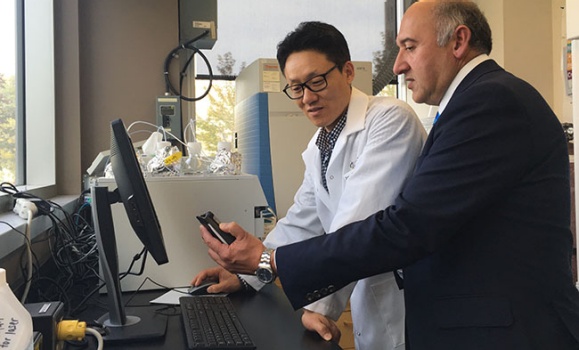» Go to news main
Linking metals in toenails to prostate cancer

What do a physician, a toxicologist, a geologist and a physicist want with toenails? To determine if there is a link between toxic metals and prostate cancer of course.
According to Prostate Cancer Canada, very little is known about the triggers of prostate cancer. There have been several previous studies that have suggested a link between toxic metals like cadmium and arsenic and prostate cancer.
Dr. Anil Adisesh, the J.D. Irving, Limited Research Chair in Occupational Medicine at Dalhousie Medicine New Brunswick is hunting for these links in toenail clippings.
Why toenails?
Toenail clippings can hold up to one month’s worth of environmental information going back six months. They are easily stored at room temperature. Additionally, the number held by Atlantic PATH makes them the ideal biometric for Dr. Adisesh’s study on prostate cancer.
Atlantic PATH made news last year for having the Guinness World Record on the number of toenail clippings, over 32,000. These toenail clippings are from residents of Atlantic Canada as part of a long-term biometric data collection. The voluntary longitudinal survey began in 2003 and includes a variety of biometric data as well as personal medical, socio-economic and occupational history of the participants.
Prostate Cancer
Funded by Prostate Cancer Canada, and New Brunswick Health Research Foundation, Dr. Adisesh is working with colleagues at Dalhousie University, University of New Brunswick, Mount Allison University, Atlantic PATH and University of British Columbia to measure the levels of toxic metals in these toenails.
The toenails Dr. Adisesh is interested in are those belonging to people who self-identified as having prostate cancer and those who are similar in age and gender but do not have this diagnosis. New Brunswick, Prince Edward Island and Newfoundland have higher than national average rates of prostate cancer. There are 149 individuals with prostate cancer who gave their toenails to the study.
The second phase of the study will examine the toenails of survey participants who since their original participation have identified as developing prostate cancer. These participants are still being surveyed.
Testing toenails
The testing will take place at Dalhousie University in toxicologist, Dr. Jong Sung Kim’s lab in Halifax. The inductively coupled plasma mass spectrometry (ICP-MS) test (shown in the photo above) is viewed as the gold standard test for metals. The process is destructive to the sample used as it is digested in nitric acid and then burned. However the team is working in collaboration to develop non-destructive methods.
These tests will be conducted in New Brunswick with minimal damage done to the samples. UNB’s geologist, Prof. Chris McFarlane, will use laser ablation to examine the presence of metals in the toenails. Mount Allison’s physicist Prof. David Fleming will use X-rays to determine presence of the metals.
When asked why these metals are the focus of this study, Dr. Adisesh highlights that “[u]nderstanding the relationship of metal toxicity and carcinogenesis is important in order to inform both preventative and screening practices.”
Recent News
- Dalhousie’s first physician assistant cohort steps into Nova Scotia’s healthcare system
- Dalhousie med students explore pediatric care in Austria
- Dalhousie researchers shine at Discovery Awards with four top honours
- New $2M national study to uncover how biology, social factors shape MS outcomes
- Pathology EDIA Committee makes strides during 2024‑2025 year
- CCfV’s impact on vaccine innovation
- Unlocking the secrets of memory—with fruit flies
- Celebrating mobility research and the power of philanthropy
